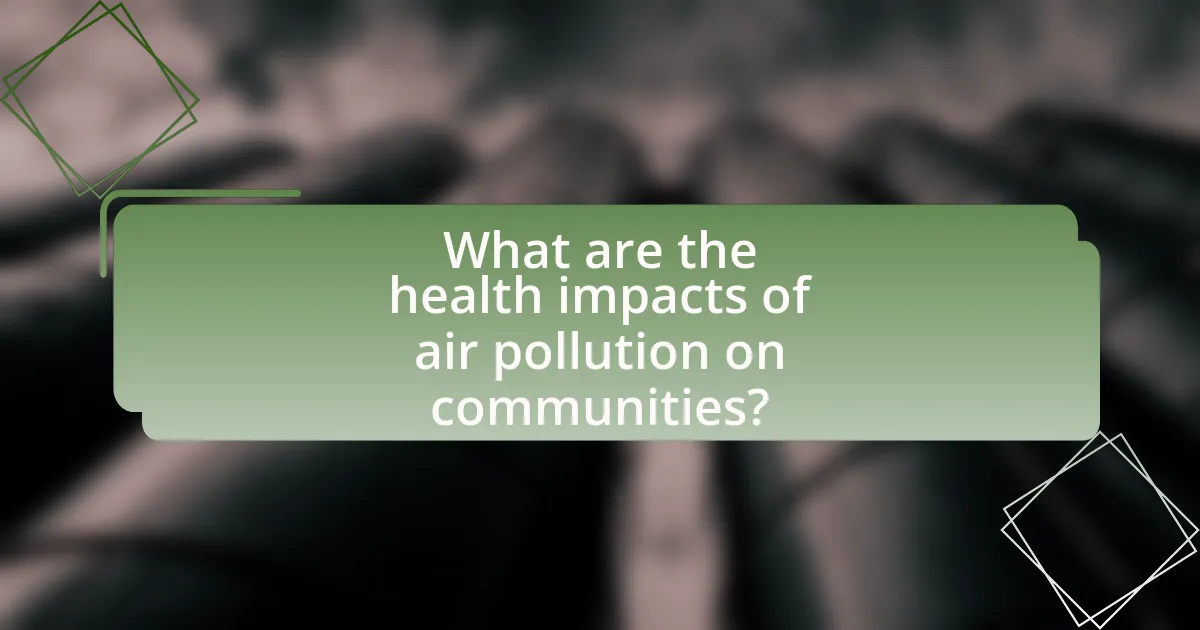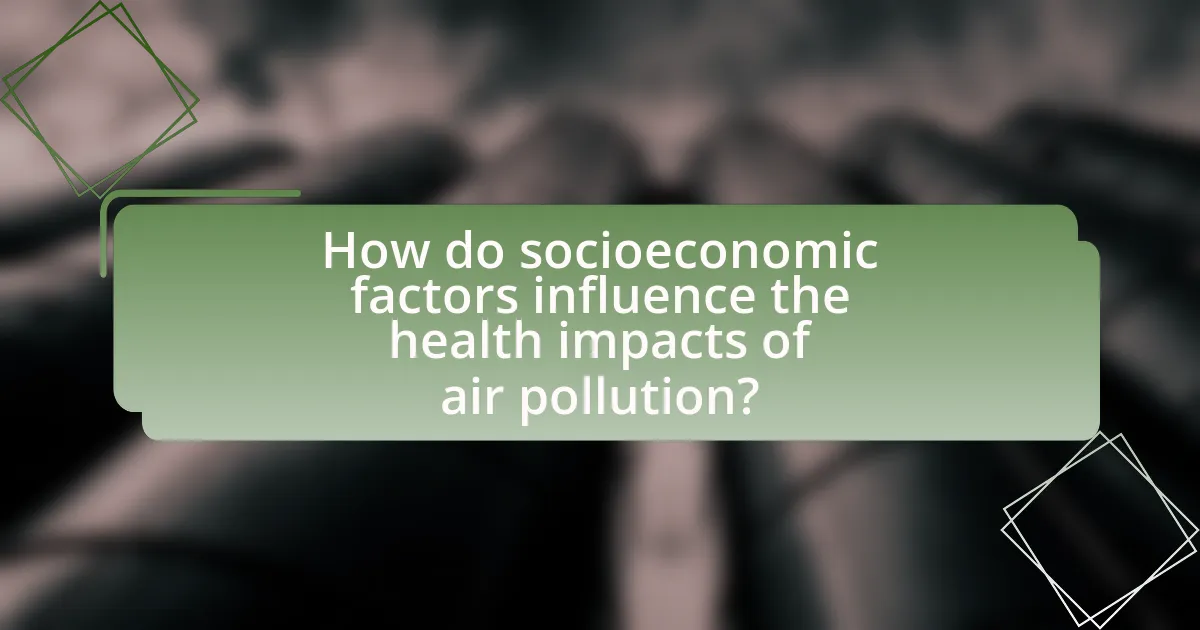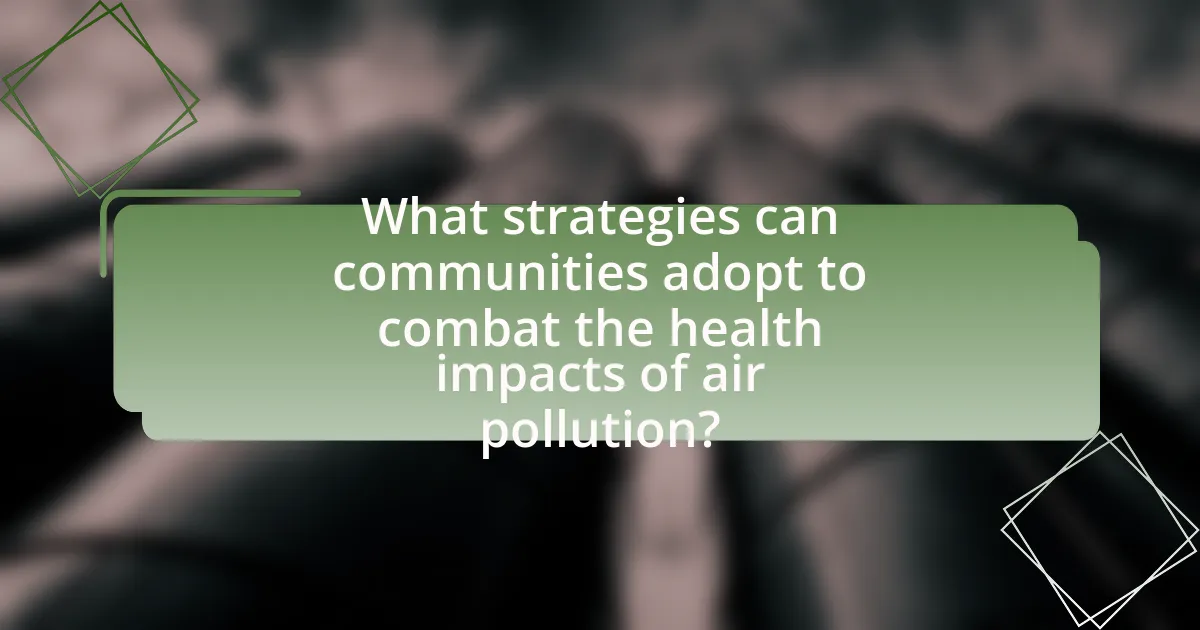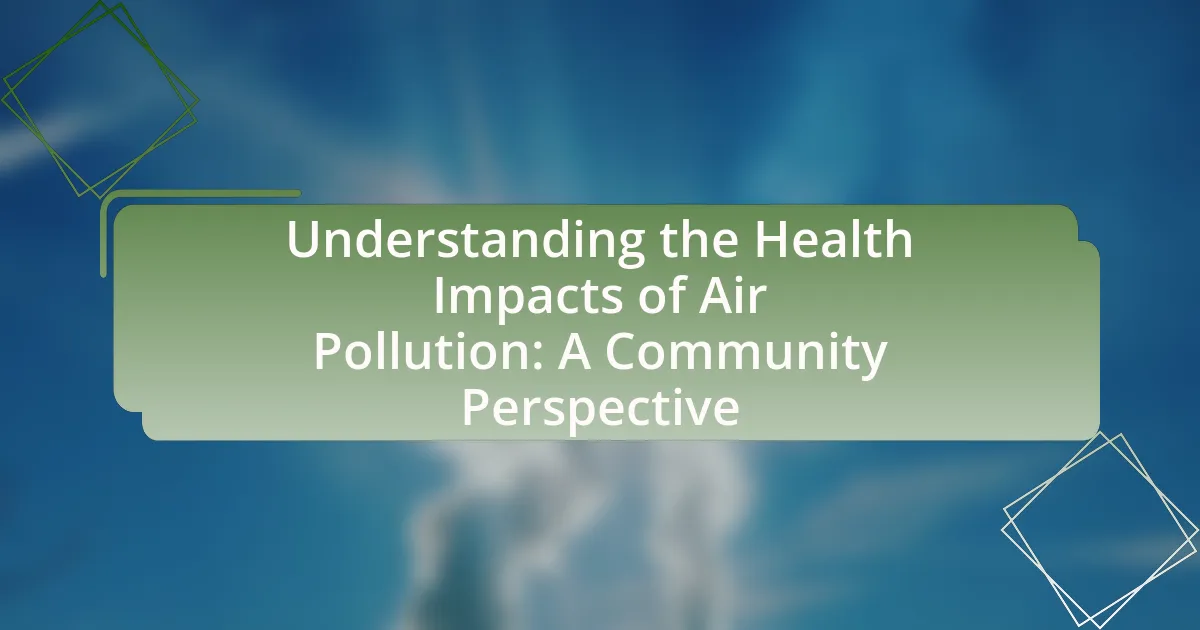The article “Understanding the Health Impacts of Air Pollution: A Community Perspective” examines the significant health consequences of air pollution on communities, highlighting its links to respiratory diseases, cardiovascular issues, and mental health disorders. It discusses how exposure to pollutants such as particulate matter and nitrogen dioxide exacerbates conditions like asthma and chronic obstructive pulmonary disease (COPD), particularly affecting vulnerable populations such as children and the elderly. The article also explores the role of socioeconomic factors in determining exposure levels and health outcomes, emphasizing the need for community engagement and education to mitigate the adverse effects of air pollution. Additionally, it outlines strategies for communities to advocate for stronger air quality protections and improve public health through effective policies and awareness initiatives.
What are the health impacts of air pollution on communities?

Air pollution significantly impacts the health of communities, leading to respiratory diseases, cardiovascular problems, and increased mortality rates. Studies indicate that exposure to pollutants such as particulate matter and nitrogen dioxide correlates with higher incidences of asthma and chronic obstructive pulmonary disease (COPD). For instance, the World Health Organization reports that outdoor air pollution causes approximately 4.2 million premature deaths globally each year, highlighting its severe health consequences. Additionally, children and the elderly are particularly vulnerable, experiencing heightened risks of developmental issues and exacerbated health conditions due to poor air quality.
How does air pollution affect respiratory health?
Air pollution significantly harms respiratory health by exacerbating conditions such as asthma, chronic obstructive pulmonary disease (COPD), and lung infections. Exposure to pollutants like particulate matter, nitrogen dioxide, and sulfur dioxide leads to inflammation of the airways, reduced lung function, and increased susceptibility to respiratory infections. Studies indicate that long-term exposure to high levels of air pollution can result in a 20% increase in respiratory-related hospital admissions, highlighting the direct correlation between air quality and respiratory health outcomes.
What specific respiratory diseases are linked to air pollution?
Air pollution is linked to several specific respiratory diseases, including asthma, chronic obstructive pulmonary disease (COPD), and lung cancer. Studies have shown that exposure to pollutants such as particulate matter, nitrogen dioxide, and sulfur dioxide can exacerbate asthma symptoms and increase the frequency of asthma attacks. Research indicates that long-term exposure to air pollution is a significant risk factor for developing COPD, characterized by persistent respiratory symptoms and airflow limitation. Additionally, the International Agency for Research on Cancer classifies outdoor air pollution as a carcinogen, with evidence linking it to an increased risk of lung cancer.
How does long-term exposure to air pollution influence respiratory health?
Long-term exposure to air pollution significantly deteriorates respiratory health by increasing the risk of chronic respiratory diseases such as asthma, chronic obstructive pulmonary disease (COPD), and lung cancer. Studies have shown that fine particulate matter (PM2.5) and other pollutants can lead to inflammation and damage in the airways, resulting in reduced lung function and exacerbated symptoms in individuals with pre-existing conditions. For instance, research published in the journal “Environmental Health Perspectives” indicates that long-term exposure to PM2.5 is associated with a 20% increase in the risk of developing respiratory diseases. Additionally, the World Health Organization reports that air pollution is responsible for approximately 4.2 million premature deaths annually, highlighting its severe impact on respiratory health globally.
What are the cardiovascular effects of air pollution?
Air pollution has significant cardiovascular effects, including increased risk of heart disease, hypertension, and stroke. Exposure to particulate matter and other pollutants can lead to inflammation, oxidative stress, and endothelial dysfunction, which are critical factors in the development of cardiovascular diseases. Studies have shown that long-term exposure to air pollution correlates with a higher incidence of myocardial infarction and heart failure, with research indicating that a 10 µg/m³ increase in PM2.5 can raise the risk of cardiovascular mortality by approximately 10%.
How does air pollution contribute to heart disease?
Air pollution contributes to heart disease primarily through the inhalation of fine particulate matter and toxic gases, which can lead to inflammation and oxidative stress in the cardiovascular system. Studies have shown that exposure to air pollutants, such as PM2.5 and nitrogen dioxide, is associated with increased rates of heart attacks, strokes, and other cardiovascular events. For instance, research published in the Journal of the American College of Cardiology indicates that long-term exposure to air pollution can elevate the risk of coronary artery disease by 20% to 30%. This evidence underscores the direct link between air quality and heart health, highlighting the significant public health implications of air pollution.
What populations are most vulnerable to cardiovascular impacts from air pollution?
Populations most vulnerable to cardiovascular impacts from air pollution include the elderly, individuals with pre-existing heart and lung conditions, children, and low-income communities. The elderly are at increased risk due to age-related decline in cardiovascular health, while individuals with pre-existing conditions such as asthma or heart disease experience exacerbated symptoms from pollutants. Children are particularly susceptible because their respiratory systems are still developing, and they often have higher exposure levels due to outdoor activities. Low-income communities frequently face higher pollution levels and have limited access to healthcare, compounding their vulnerability. Studies have shown that exposure to fine particulate matter (PM2.5) is linked to increased cardiovascular morbidity and mortality, particularly in these at-risk groups.
What mental health issues are associated with air pollution exposure?
Air pollution exposure is associated with various mental health issues, including anxiety, depression, and cognitive decline. Studies have shown that individuals living in areas with high levels of air pollution experience increased rates of these mental health disorders. For instance, research published in the journal “Environmental Health Perspectives” found a significant correlation between elevated particulate matter levels and the prevalence of anxiety and depression among urban populations. Additionally, a study conducted by the University of California, Berkeley, indicated that long-term exposure to air pollution can lead to cognitive impairments, particularly in older adults. These findings underscore the detrimental impact of air pollution on mental health, highlighting the need for public health interventions to mitigate exposure.
How does air pollution affect cognitive function?
Air pollution negatively impacts cognitive function by impairing attention, memory, and decision-making abilities. Studies have shown that exposure to fine particulate matter (PM2.5) and other pollutants is associated with decreased cognitive performance and increased risk of neurodegenerative diseases. For instance, research published in the journal “Environmental Health Perspectives” found that long-term exposure to air pollution is linked to a decline in cognitive abilities in older adults, with a significant correlation between higher pollution levels and lower scores on cognitive tests. This evidence underscores the detrimental effects of air pollution on brain health and cognitive processes.
What is the relationship between air pollution and anxiety or depression?
Air pollution is significantly associated with increased levels of anxiety and depression. Studies have shown that exposure to pollutants, such as particulate matter and nitrogen dioxide, can lead to neuroinflammation and oxidative stress, which are linked to mental health disorders. For instance, research published in the journal “Environmental Health Perspectives” found that higher levels of air pollution correlate with a greater incidence of anxiety and depression symptoms among urban populations. This evidence indicates that the detrimental effects of air pollution extend beyond physical health, impacting mental well-being as well.
How do socioeconomic factors influence the health impacts of air pollution?

Socioeconomic factors significantly influence the health impacts of air pollution by determining exposure levels and vulnerability to health effects. Individuals in lower socioeconomic groups often reside in areas with higher pollution levels due to industrial activities and traffic, leading to increased exposure. Additionally, these populations may lack access to healthcare, making them more susceptible to the adverse health effects of air pollution, such as respiratory diseases and cardiovascular issues. Studies indicate that low-income communities experience higher rates of asthma and other pollution-related health problems, highlighting the correlation between socioeconomic status and health outcomes in polluted environments.
What role does income level play in exposure to air pollution?
Income level significantly influences exposure to air pollution, with lower-income communities often facing higher levels of pollution. Research indicates that economically disadvantaged areas are frequently located near industrial sites, highways, and other pollution sources, leading to increased exposure. For instance, a study published in the journal “Environmental Health Perspectives” found that low-income neighborhoods in urban areas experience higher concentrations of particulate matter and other pollutants compared to wealthier areas. This disparity is attributed to factors such as reduced political power, limited access to resources for pollution mitigation, and inadequate urban planning, which collectively exacerbate health risks associated with air pollution in lower-income populations.
How does living in low-income areas correlate with higher pollution levels?
Living in low-income areas correlates with higher pollution levels due to factors such as industrial proximity, inadequate infrastructure, and limited political power. Residents in these neighborhoods often face higher exposure to pollutants from nearby factories and highways, as these facilities are frequently located in economically disadvantaged regions. A study by the Environmental Protection Agency found that low-income communities are disproportionately affected by air pollution, with 56% of people living near hazardous waste sites being from low-income backgrounds. This correlation is further exacerbated by a lack of resources for pollution control and advocacy, leading to poorer health outcomes for these populations.
What are the health disparities faced by low-income communities regarding air quality?
Low-income communities face significant health disparities related to air quality, including higher rates of respiratory diseases, cardiovascular issues, and overall poorer health outcomes. These communities often reside in areas with elevated pollution levels due to proximity to industrial sites, highways, and other sources of emissions. For instance, studies indicate that low-income neighborhoods experience 1.5 times more air pollution than wealthier areas, leading to increased incidences of asthma and other chronic conditions. Additionally, limited access to healthcare exacerbates these health issues, as residents may struggle to receive timely medical attention or preventive care.
How does education level affect awareness and response to air pollution?
Education level significantly affects awareness and response to air pollution, as individuals with higher education tend to have greater knowledge about environmental issues and their health impacts. Research indicates that educated individuals are more likely to understand the sources and consequences of air pollution, leading to proactive behaviors such as advocating for cleaner air policies and adopting personal measures to reduce exposure. For instance, a study published in the journal Environmental Research found that individuals with a college degree were 30% more likely to engage in activities aimed at reducing air pollution compared to those with only a high school education. This correlation highlights the importance of education in fostering environmental awareness and promoting effective responses to air quality challenges.
What educational initiatives can help communities mitigate air pollution effects?
Educational initiatives that can help communities mitigate air pollution effects include awareness campaigns, school-based environmental education programs, and community workshops focused on sustainable practices. Awareness campaigns inform residents about the sources and health impacts of air pollution, encouraging behavioral changes that reduce emissions. School-based programs engage students in learning about air quality and environmental stewardship, fostering a generation that prioritizes clean air. Community workshops provide practical skills, such as urban gardening and energy conservation, which can directly reduce local pollution levels. Research indicates that communities with active educational initiatives experience improved air quality and public health outcomes, demonstrating the effectiveness of these approaches.
How does community engagement influence health outcomes related to air pollution?
Community engagement significantly influences health outcomes related to air pollution by fostering collective action and awareness among residents. Engaged communities are more likely to advocate for policy changes, implement local interventions, and participate in monitoring air quality, which can lead to reduced exposure to pollutants. For instance, studies have shown that neighborhoods with active community groups often experience lower levels of air pollution-related health issues, such as asthma and respiratory diseases, due to their efforts in promoting cleaner air initiatives and holding industries accountable. This correlation is supported by research from the American Public Health Association, which highlights that community-driven efforts can effectively mitigate the adverse health effects of air pollution through increased public awareness and proactive measures.
What strategies can communities adopt to combat the health impacts of air pollution?

Communities can adopt several strategies to combat the health impacts of air pollution, including implementing stricter air quality regulations, promoting public transportation, and increasing green spaces. Stricter regulations can limit emissions from industrial sources and vehicles, thereby improving air quality. Promoting public transportation reduces the number of cars on the road, which decreases traffic-related pollution. Additionally, increasing green spaces, such as parks and urban forests, can help absorb pollutants and improve overall community health. These strategies are supported by studies showing that improved air quality leads to better health outcomes, such as reduced respiratory diseases and lower rates of cardiovascular issues.
How can local governments implement effective air quality regulations?
Local governments can implement effective air quality regulations by establishing stringent emission standards for industries and vehicles. These regulations should be based on scientific research that identifies harmful pollutants and their health impacts, such as respiratory diseases linked to particulate matter and nitrogen oxides. For instance, the U.S. Environmental Protection Agency (EPA) sets National Ambient Air Quality Standards (NAAQS) that local governments can adopt to ensure compliance with health-based air quality criteria. Additionally, local governments can enhance monitoring systems to track air quality in real-time, enabling timely responses to pollution spikes. Engaging the community through public awareness campaigns about the importance of air quality and encouraging participation in local decision-making can further strengthen these regulations.
What are successful examples of air quality policies in other communities?
Successful examples of air quality policies in other communities include the implementation of the Clean Air Act in the United States, which has led to significant reductions in air pollutants. For instance, cities like Los Angeles have adopted stringent vehicle emission standards and expanded public transportation, resulting in a 50% decrease in smog levels since the 1970s. Additionally, the city of Beijing has implemented a comprehensive air quality management plan that includes restrictions on coal burning and the promotion of electric vehicles, contributing to a 30% reduction in PM2.5 levels over recent years. These policies demonstrate effective strategies for improving air quality and public health.
How can communities advocate for stronger air quality protections?
Communities can advocate for stronger air quality protections by organizing grassroots campaigns that raise awareness about air pollution’s health impacts and mobilizing residents to engage with local policymakers. For instance, studies show that community-led initiatives, such as the “Breathe Easy” campaign in Los Angeles, effectively influenced local legislation by demonstrating the correlation between air quality and respiratory health issues, leading to stricter emissions regulations. Engaging in public forums, collaborating with environmental organizations, and utilizing social media platforms to disseminate information further empower communities to push for necessary changes in air quality standards.
What role does public awareness play in reducing air pollution health impacts?
Public awareness plays a crucial role in reducing air pollution health impacts by informing individuals about the sources and effects of air pollution, which can lead to behavioral changes and advocacy for cleaner air policies. Increased public knowledge encourages communities to engage in actions such as reducing vehicle emissions, supporting renewable energy initiatives, and participating in local environmental programs. Studies have shown that communities with higher levels of awareness about air quality issues tend to have lower pollution levels and better health outcomes, as individuals are more likely to adopt practices that mitigate exposure to harmful pollutants. For instance, a report by the World Health Organization indicates that public engagement in air quality monitoring and advocacy can significantly influence policy changes that lead to improved air quality and health benefits.
How can community education programs raise awareness about air pollution risks?
Community education programs can raise awareness about air pollution risks by providing targeted information and resources to local populations. These programs often include workshops, seminars, and informational campaigns that educate residents about the sources and health effects of air pollution, such as respiratory diseases and cardiovascular issues. For instance, a study by the Environmental Protection Agency found that community engagement initiatives significantly increased knowledge about air quality and its health impacts, leading to more proactive behaviors among participants. By utilizing local data and case studies, these programs can effectively illustrate the relevance of air pollution to the community, fostering a sense of urgency and encouraging collective action to mitigate risks.
What practical steps can individuals take to protect their health from air pollution?
Individuals can protect their health from air pollution by minimizing outdoor activities during high pollution days, using air purifiers indoors, and wearing masks designed to filter out pollutants. Monitoring local air quality indexes helps individuals determine when to limit exposure. Research indicates that staying indoors on days with poor air quality can significantly reduce inhalation of harmful particles, thereby lowering health risks associated with respiratory and cardiovascular diseases. Additionally, using HEPA filters in homes can effectively reduce indoor air pollution, contributing to better overall health.

Leave a Reply